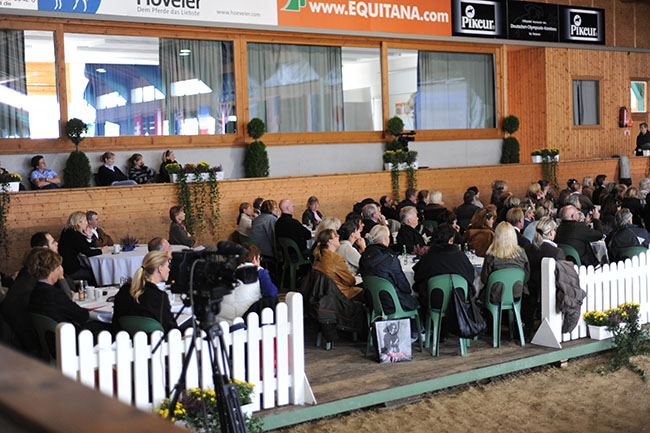
It has always amazed me, that the Germans, despite having the most educated and knowledgeable, equestrian spectators in the world, continually grab every opportunity to add to that knowledge. In the judging of the German Young Horse Show Case – the Bundeschampionate – the judges take every opportunity to explain to the spectators WHY they have made their decisions, and if there is a break in the action, there is just as likely to be a mini-clinic happening in the arena.
In 2009, for the first time, the German FN, extended this opportunity to learn to the worlds English speaking enthusiasts, organizing the first ever, Seminar of the German Federation about Training and Judging Young Dressage Horses for Judges, Dressage stewards, Trainers, Veterinarians and people interested in Dressage.
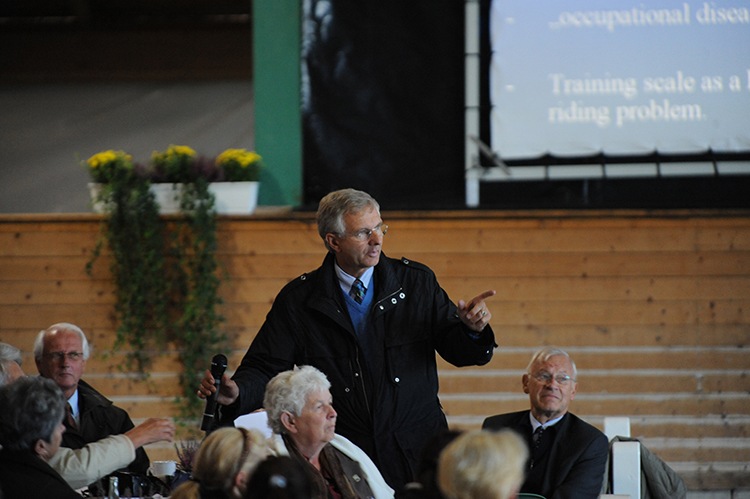
The chief mover-and-shaker behind the Seminar was German judge, trainer, and educator, Christoph Hess, and it was Christoph’s infectious enthusiasm that kept this seminar bubbling along.
The Bundeschampionate runs from Wednesday through to Sunday, but the seminar briefing sessions commenced on the Saturday with 125 delegates from 25 countries. Participants were taken on a guided tour, then watched the Five-Year-Old Final, with the bonus of an instant English language commentary through the special head-phones. The day finished with a discussion session reviewing the events of the day. It was much the same on the Sunday, with delegates again treated to an instant English commentary for the Six-Year-Old Dressage Final, but it was the next day, when things started to get serious.
The delegates were back in the big indoor school – usually the scene of the Dressage Ponies competition, on the Monday morning for an extraordinary lineup of speakers, trainers, riders, and most amazing of all, horses!!! Seemingly every top rider and trainer had made their horses available for the seminar – including some of the big winners from the Bundeschampionate weekend.
The day started off with a view from the Judges’ Stand…
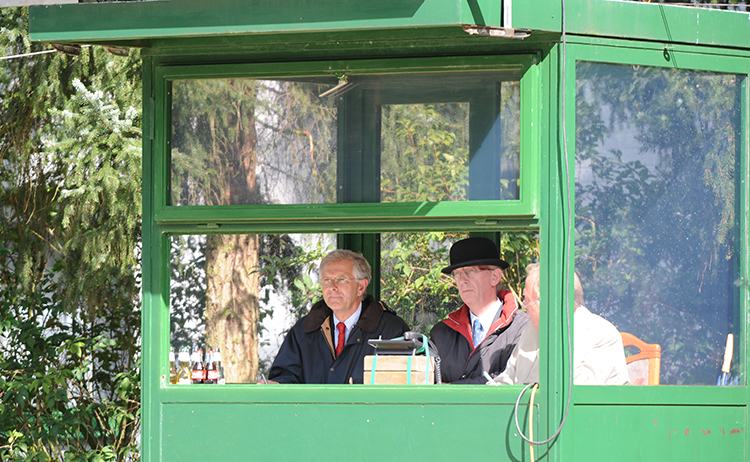
In the judges’ stand, Christoph Hess and Dr Schule
The view from the Judges’ Stand
On of the first speakers, Dr Dieter Schüle has judged in Australia, and he is a regular on the judging panel at the Bundeschampionate. His paper, Dressage Horses – from a Judge’s Perspective set the framework. Dr Schüle started by talking about the way in which the three of the ‘stake-holders’ interact in the process: the breeder, the rider, the judge, and the correct conformation for the dressage horse.
“Each rider / breeder aims at the ideal horse which has a perfect conformation, charisma, medium frame and expressive gaits.”
From the breeders’ point of view the ‘product’ should demonstrate correctness and expression. Dr Schüle suggested that breeders tended to under-estimate the value of performance on the part of the mare, and over-estimate the value of the stallions which are ‘in vogue’. It was dangerous to breed to high priced, highly advertised stallions, who when their progeny at the age of three or four showed problems, immediately disappeared…
From the riders’ point of view, the good horses were those which are easy to handle and comfortable to ride. Again, he suggested that the breeders often under-estimated the importance of temperament, character and motivation in the horses, and produced horses that were difficult to handle. For the rider, a good horse is fun.
“Breeders should work together with riders and trainers and get a feedback about character, temperament and motivation.”
In the middle of all this was the Judge who had a crucial role:
“The judge has to evaluate the horse’s performance and should give direction for improvement of the – horse, training, and, the rider.”
The Dressage Horse should be:
* Of medium size – 1.70m (16.3hh) – with correct anatomy
The ideal: * Uphill conformation * Long legged * A balance between a square frame and a rectangular frame – the rectangular, long horse could have problems with the hindlegs, while a horse that was too short and square, could have problems with suppleness * A well developed croup, since this is the motor of the horse.
However, Dr Schüle did flash up on the screen photos of Rembrandt and Gigolo to demonstrate that ‘deficiencies in conformation can be compensated by training.
The neck: Should be naturally uphill and arched; Smooth transition from the neck to the head through the throat latch; Adequate length of neck – too short, problems with contact, too long, difficulties in keeping the poll as the highest point; The muscles should be on the upper side of the neck; the origin of the neck at the shoulder was of particular importance, the neck should come high out of the shoulder and be strong enough – muscles can be developed, but the origin of the neck cannot be changed.
The forehand – Regulating Ground Cover
* 60% of the horse’s weight is on the forehand by nature but by correct training this is changed with increasing collection. Long front legs are desirable and the Thoroughbred is important in producing these longer legs.
* The Shoulder should be long and sloping for a better ground cover. The shoulder is important because it influences the position of the saddle – too steep and it forces the saddle back.
* The importance of the Upper Arm is often under-estimated. A long upper arm is important for good ground covering.
* The elbow is important and enough space between it and the body is necessary for the horse to execute the lateral movements. When the elbow is tight to the body, the horse has no freedom of movement. It’s good if you can place your hand between the horse’s elbow and its body.
* The position of the front legs, they must be correct and straight. The fetlock is important for elasticity.
read on below
The back / loin – The Bridge
The longer the back, the more problems the horse will have with engagement. The top line of the horse should be straight, not hollowed and not too high at the croup.
The hindquarters / croup – carrying weight: ‘The Motor”
The croup should be well shaped with developed muscles, it should be long enough with the correct angles of the haunches.
Problems: A high tail set with the hindlegs standing out behind leads to not enough engagement
Correct angles and development of the muscles are a good precondition for the activity of the hindquarters. The angle should be 90 degrees with the hocks under the horse. Hocks that are too close together have trouble carrying weight.
The Basic Gaits should show: * clear rhythm * relaxation * Elasticity – swinging back * Good impulsion (not walk) * Balance * Active, bending joints of hindquarters * Good freedom of shoulder
The walk should show a clear four-beat rhythm. A steady rhythm not ‘short and long’. Activity – a powerful push-off, out of the hindlegs – not too slow and laboured or fixed in the back. The judges are looking for good Ground Cover – many judges just look at the over-step and forget to look, is the horse coming out of the shoulder? Is it keeping the rhythm? Is the horse showing relaxed muscles in the back and along the top line? Is the horse accepting the bit and not throwing off the reins. Problems: fixed in the back, stiff front legs. Rhythm is more important than over-stepping, over-stepping too much can cause problems, two hoof widths is enough. The idea that two hoof widths overstep is worth 7, four widths is worth 9, is not correct.
The trot should be in a clear two beat rhythm, showing suppleness and a relaxed, energetic elastic swinging back. The horse should show mental calmness – a ‘happy’ attitude. Problems arise when there is a repeated loss of rhythm especially in the movements and turns, and an unevenness of the steps, or when the trot looks tense, forced or unnatural. The impulsion should come from a natural movement of suspension – not a fixed back. There should be a powerful push-off of the hindlegs, with active bending in the direction of the point of gravity. The hocks should be engaged and under the horse. Problems: not enough basic impulsion, stiff hindlegs – not bending, hock too high and behind the horse, extreme action of frontlegs not in relation to hindlegs.
The judge wants to see not only ground cover – from active hindlegs with good freedom of shoulder – but also a talent for collection – natural talent for self-carriage and carrying power of the hindquarters.
The canter: Here the judge wants to see a clear three-beat rhythm on both reins. The inside hindleg must show bending of the hock and act towards the point of gravity, but the outside hindleg must also be engaged. Problems: No clear rhythm, stiff hindlegs without active haunches. The judge also wants to see a bending ‘round’ frontleg because this helps in the collection and the changes. He is looking for an uphill tendency with self-carriage and balance.
Problems: Coming on forehand, high croup, stiff frontleg.
Rideability: The correct training of a dressage horse should be in relation to the scale of training and all steps of the scale should be fulfilled in the right order.
The quality of a dressage horse: Temperament, willingness to perform, character, learning aptitude. A sensitive horse which is eager to go forward is preferred to a lazy and unmotivated horse. Young horses can be spooky but still good for dressage.
The Breeder’s Point of View:
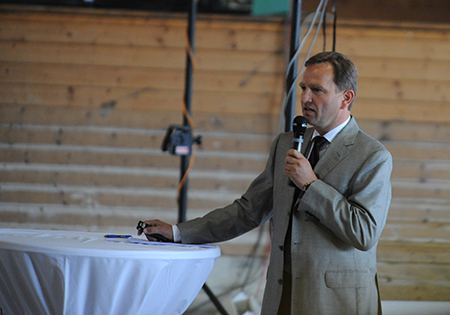
Who better to give an overview of the Breeding of Dressage Horses, than Dr Werner Schade, the head of the Hanoverian Verband. With 19,880 registered broodmares, the Hanoverians lead the world when it comes to producing dressage horses – and each year over 1000 horses of their horses, are sold to some 30 countries around the world. Six of the top ten horses on the World Breeding Federation standings, carry the Hanoverian brand.
Werner demonstrated just how selective the Hanoverian process is.
Of the 19,000 mares, 13,000 are bred each year to produce 8,000 foals. The 4,000 filly foals are evaluated at the mares shows, between the age of two and six, and after they turn three, are eligible for studbook inspection, and also to take part in the mare tests. The colt foals can go to a pre-selection for the licensing, and if they are successful there, on to a performance test at the age of three.
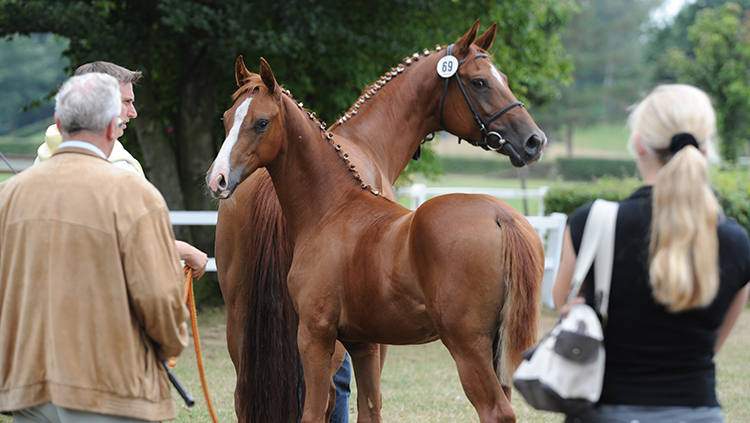
In the 70 day stallion performance test, the trainer evaluates the mental qualities – character, temperament, willingness to work, constitution – as well as the basic gaits – trot, canter, walk, rideability and jumping ability. The judges assess the young stallions for their basic traits – trot, canter, walk, free-jumping (scope and ability) as well as the cross country test which looks at jumping scope and cross country canter. The test rider assesses: Rideability and Jumping Ability.
A study by Axel Brockmann (now the head of Celle) found that there was a correlation of 0.70 between the stallion performance test and success in young horse classes for dressage horses, and 0.87 with success in dressage competition. The stallion performance test had a correlation of 0.75 for young jumping horse classes and 0.78 for showjumping competiton.
It is similar in the mare tests, where the young mares are scored for their basic gaits, rideability and jumping. All the information from these tests – the stallion and the mare performance tests, the classes for young horses, and competition – go towards the FN breeding values for that stallion. The Hanoverians also have an estimation of breeding values that is slightly differently calculated, in that it takes the information from the studbook inspections, the mare performance tests, and the observations that come out of the inspections of horses put forward for the auctions.
Like Dr Schule, Werner saw a close relationship between the breeders, the sport and the judges. The breeders provided the horses for the sport, while the sport produced the data for the estimation of breeding values. Sport is a tool for sales and marketing while at the same time providing information for the breeder. However, this produces a few unresolved questions – are the breeders producing horses for amateurs or for professionals? Are they breeding for spectacular gaits or for suppleness and rideability? How do we reconcile business interests versus horse interests. Is dressage an entertainment – or a means of controlling the training, where is the balance? And in all this, the judge plays a key role, judging should be a way of encouraging good training, but sometimes spectacular gaits are rewarded over good rhythm.
The Young Horse in Action
It was refreshing to see this ‘correct’ approach in action when we got to the first of our horses, a three-year-old mare, Paola (Lord Loxley out of Poetin II by Sandro Hit) ridden by Christian Flamm. Hans-Heinrich Meyer zu Strohen who trains Christian, explained where they were at with the youngster. She had been started in January and first lunged for a couple of months. Now she was being worked under saddle, but still with the rider in a forward seat and really short spurs.
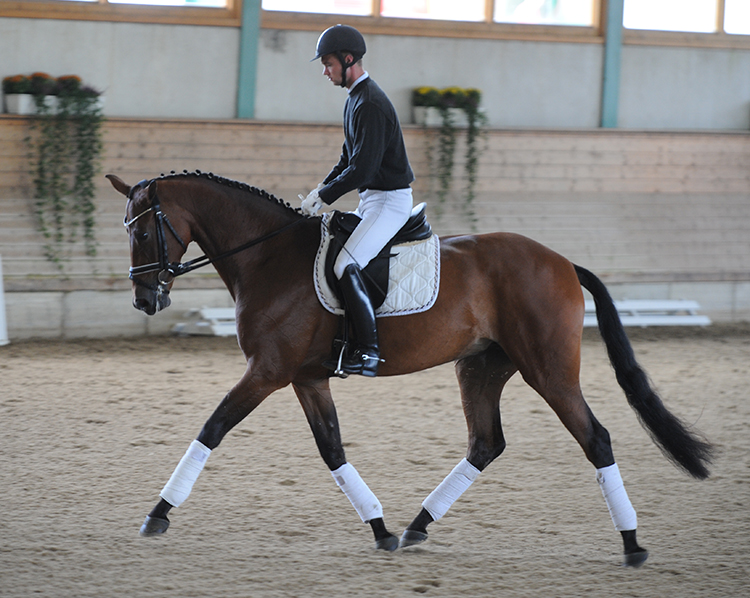
“Right from the beginning, the contact must be absolutely clear,” Hans-Heinrich stresses. “First on both reins equally, then more to the outside rein. Try to get the reins a little longer, work on the rhythm and the position of her neck. If you get the neck too high, then later you have problems – if you ride them this way, you don’t need a vet.”
“At this stage we just want her to canter forward – later we will make her straight. Use the short side to get a little more activity, we don’t want a running canter, just round, round, round. In the beginning the horse must learn to accept the leg and go forward in the transition.”
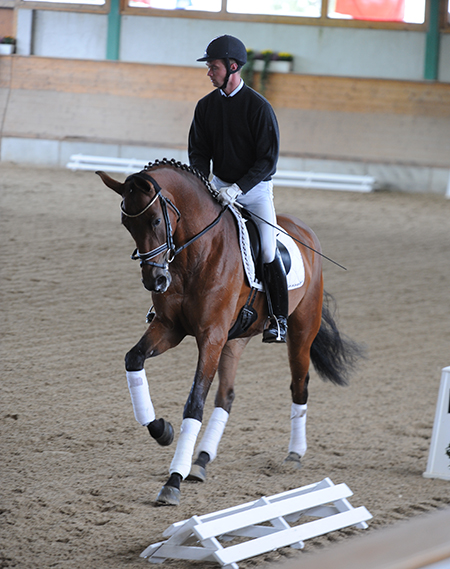
The seminar moderator, Christoph Hess points out: “Here we see rhythm, including the right tempo; suppleness/relaxation and contact. The first three things on the training scale are the most difficult to get!”
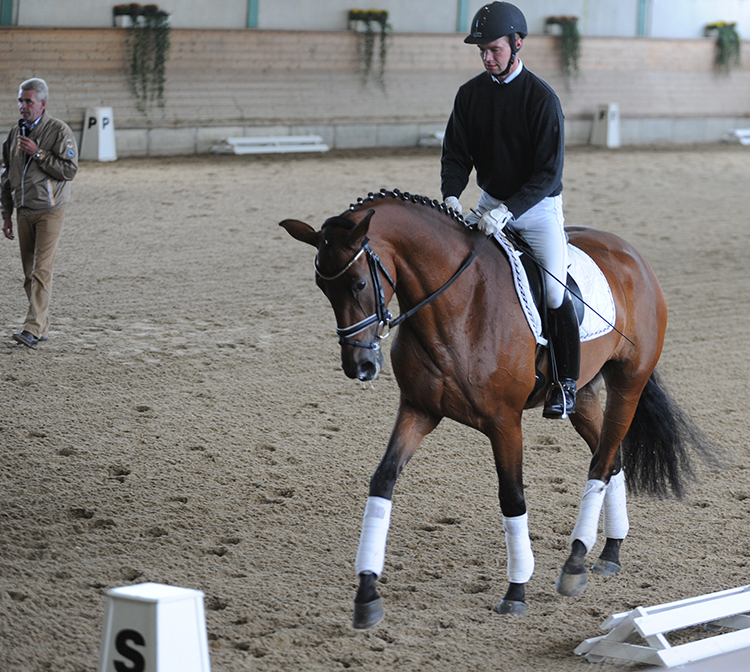
The next horse in was a four-year-old Hanoverian, Horatio by Hochadel out of a Matcho mare, ridden by Dorothee Schneider, one of those consummate German professionals who rides at every level, from babies to Grand Prix.
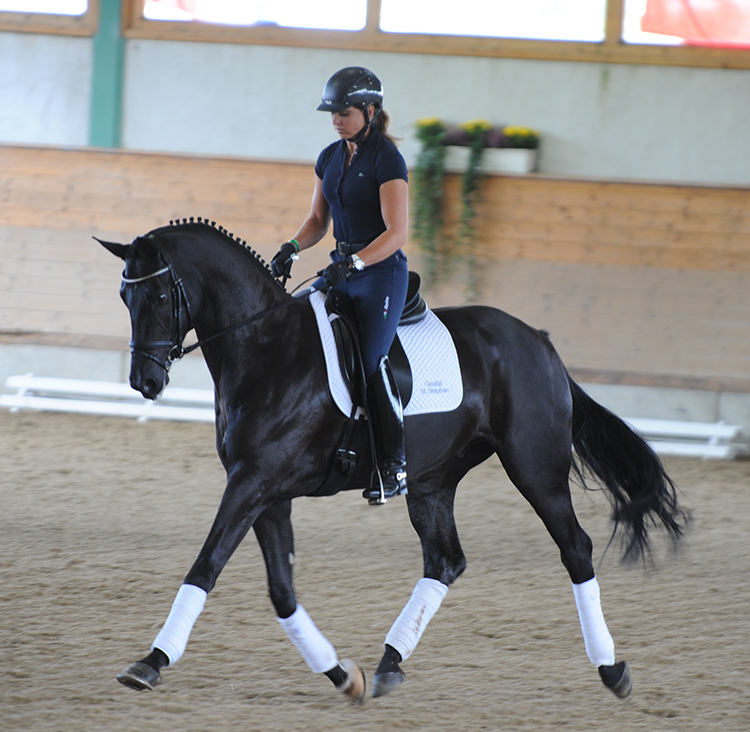
Longer strides, not medium for three and four-year-olds – Dorothee Schneider and Horatio demonstrate
This time, it was the judge (and former Grand Prix dressage competitor) Dietrich Plewa doing the commentary: “It is very important to find the right speed for each horse. In the conformation classes (ie. Riding horse classes for three and four year olds), we have serpentines to see if the horse can keep the balance – the same speed, same rhythm. Now show some longer strides. In conformation classes, we don’t ask for medium only longer strides…”
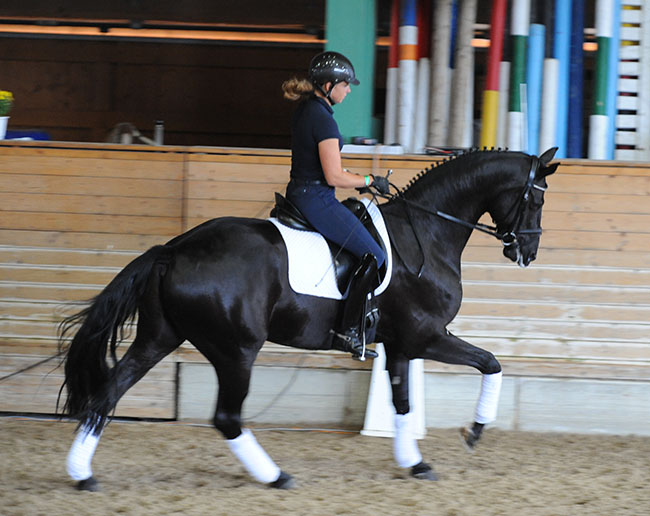
Horatio and Dorothee demonstrate canter…
At this point I am struck by the appearance of ‘clinic talk’. You know, at the judges clinics they all talk about using the full range of their marks and going really high and really low, and when they get to the competition, we are back in the 6s and 7s. In the coffee break I pointed out to Dr Plewa, that the winner of the three year old stallion class at the previous day’s Bundeschampionate, had been shown at what could only be called an exaggerated extended trot. Dr Plewa made the point that he hadn’t judged that class but agreed that it was unfortunate that some riders interpreted ‘longer’ as flat out. Treat it like an error of course, I suggested. But I suspect they won’t.
“In the canter, our first criteria is the three beat rhythm and clear uphill tendency. When we lengthen the rein, is the horse able to keep that uphill tendency and the rhythm – and not change speed even after the reins are shortened.”
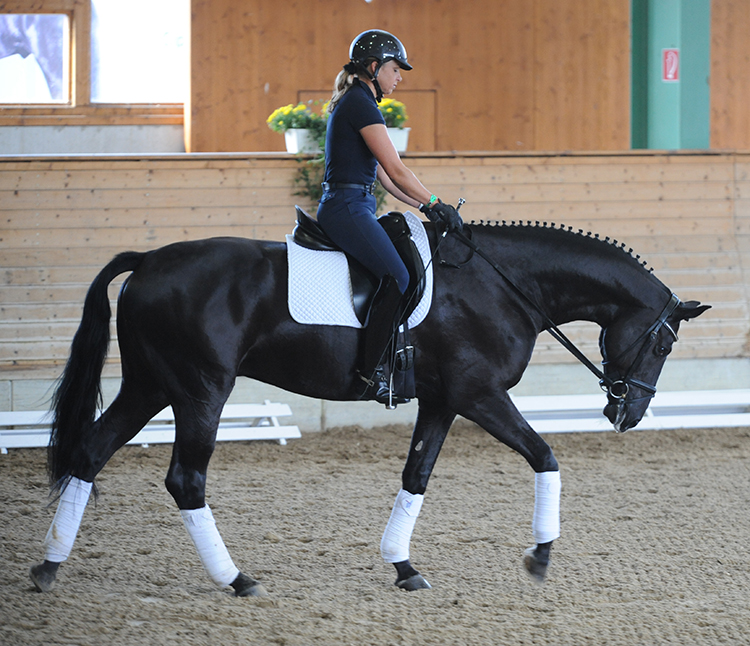
Movement through the WHOLE body, Horatio and Dorothee in walk
“The walk should be clearly four beat and it is very important that the movement should be through the horse’s WHOLE body – the horse should be marching from one point to the other. In the conformation class, long reins are not loose reins – if the reins are too long, the judge can say, please shorten the reins.”
another horse follows
The next horse was another four year old, this time the Rhineland stallion, Don Jerome (Damon Hill / Guy Laroche) ridden by a professional from the south of Germany, Uta Gräf
The next rider demonstrated how important it is for the horse to be well-balanced. According to Uta, ‘my hands are listening to the horse, small transitions are the key points for schooling the horse…’
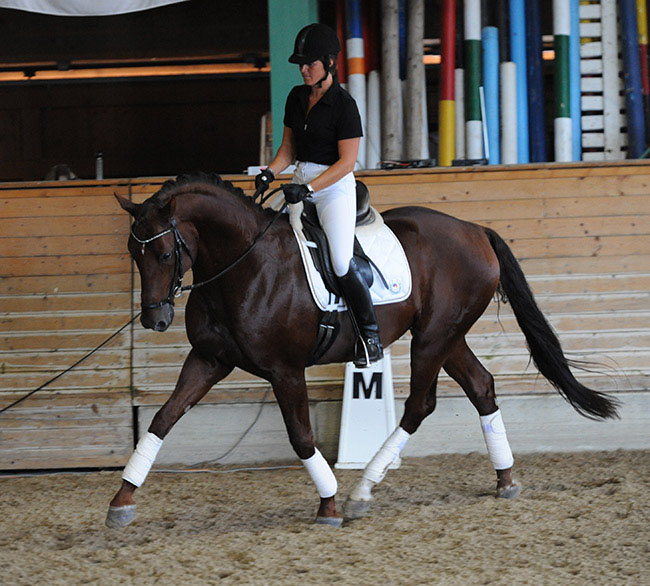
Christoph Hess was (as usual) enthusiastic: “Here we have a rider in a well-balanced position in the saddle. A rider who can develop the horse and make it happy. A rider not using spurs, not using the whip, just asking the horse with body language. The only negative point is the horse’s mouth is too dry, but she is able to ride with long reins and can play with her position. When you school a horse, you have to have a clear vision – this is how it works when you are supple and well balanced.”
Dr Plewa made the point: “this is a horse in a really good rhythm. It is a big horse but you see him, you don’t hear him.”
Next into the arena was the four year old black stallion, Sarkozy (Sandro Hit / Weltmeyer) ridden by Eva Möller, who had taken him into second place in the Four Year old stallion class at the just completed Bundeschampionate. This time, the commentary came from Eva’s husband, Ulf:
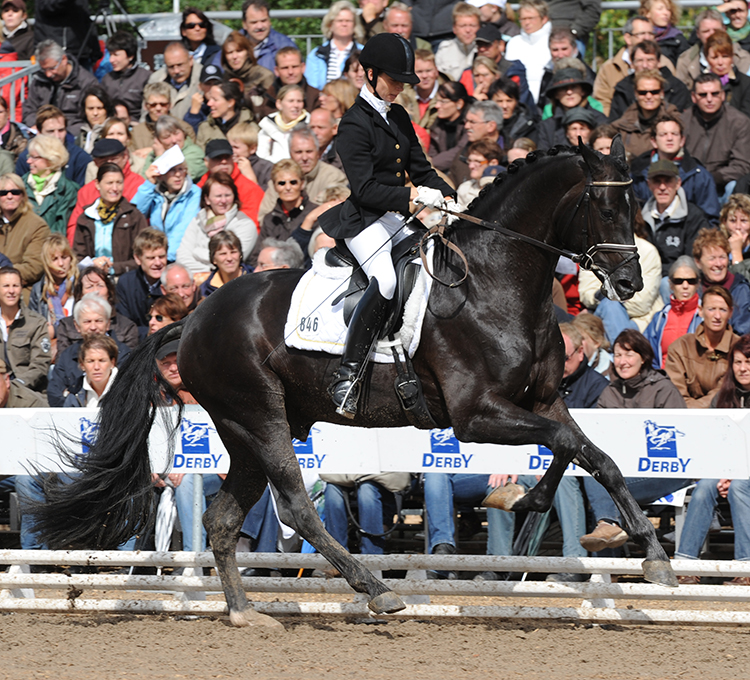
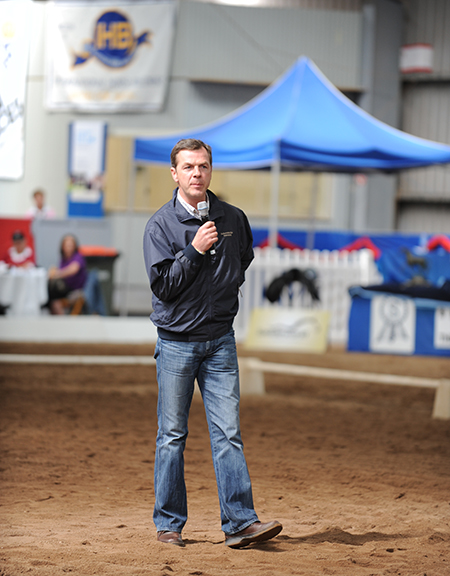
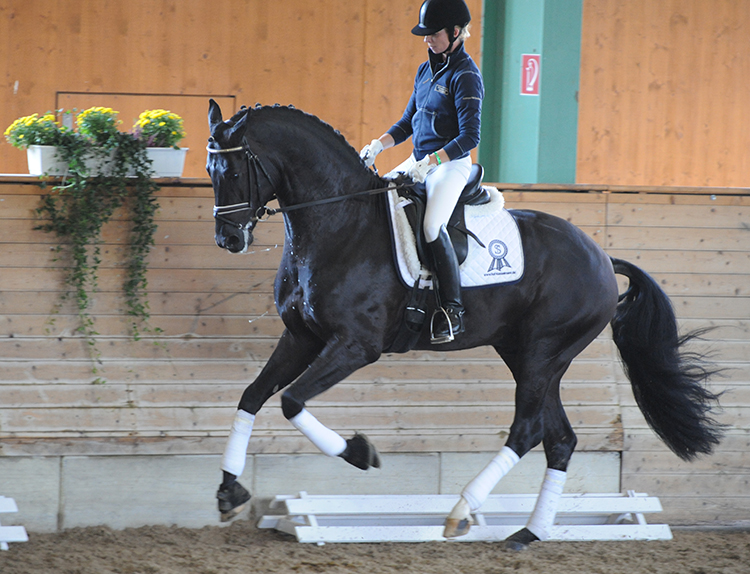
“This is a breeding stallion and you are happy when you get into the class, and he gets excited and then comes back to you. You need them to react, rather than they are always relaxed. The question is how fast they come back to you? This is a modern horse, he is uphill by nature, so in the warm-up you ride him a little down.”
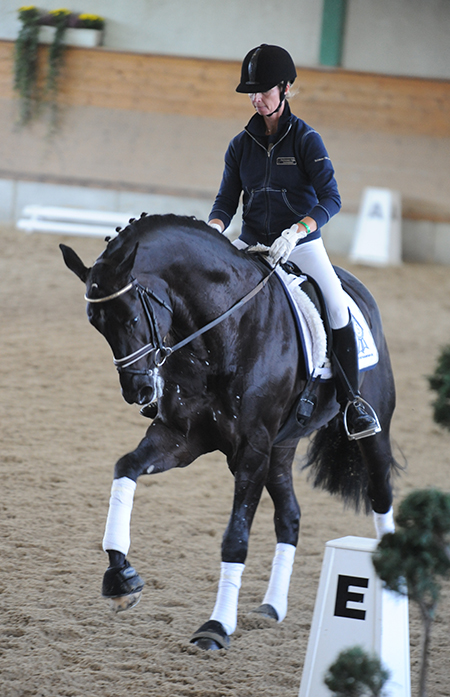
As usual, Ulf did not beat about the bush: “In the guidelines it might say ‘lengthening’ of the steps, but in the end, we are talking about medium trot. Okay now he is forging a little, the hindlegs hit the frontlegs. As the horse comes more uphill, there is more space for the hindlegs – we have to make space for the active hindlegs. The wrong thing is to always go forward. Teach the horse a little collected trot and the wide hind legs go away.”
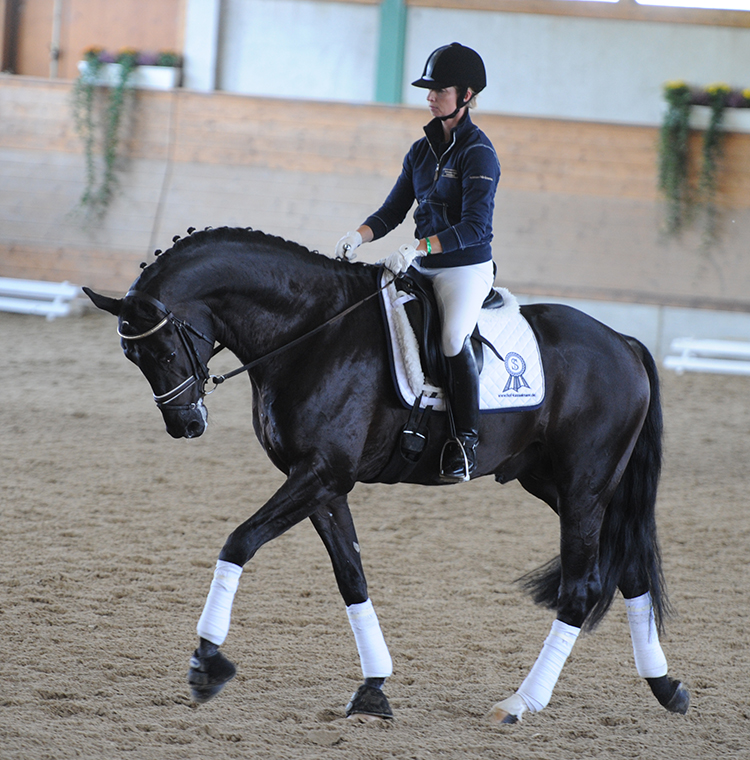
It’s always a worry in these clinics when the organizers let the mike go walk about, because there is always a nutter in the crowd with a dumb question… sure enough: “My instructor always told me that it’s medium trot kills horses…”
Ulf is a little taken aback: “The shortening of a horse’s life does not come from medium trot – and we don’t ride medium trot every day. In the end we ride the horse very active behind, and always on a good footing.”
Then another rider from Ulf’s PSI stables, Steffi Kerner, who was riding the Trakehner stallion, Grand Passion (Oliver Twist / Polarion). Steffi is one of the stars of the PSI team, having ridden for the stable for the past 13 years. The brown stallion is out a mare who is the full-sister to Grafenstolz who qualified for the Bundeschampionate in dressage, showjumping and eventing.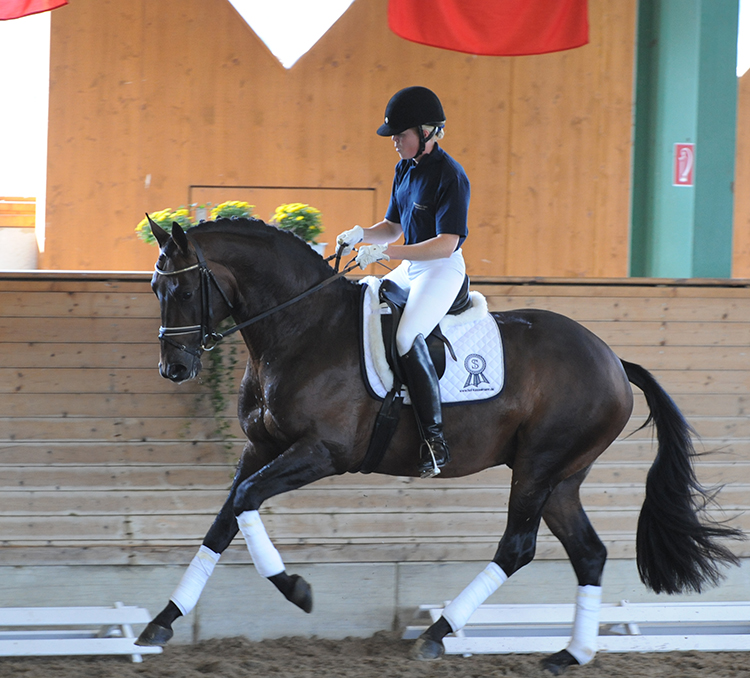 According to Ulf: “The trot will come with this horse with work, also with a little work in hand, the front leg will come – but here we have a canter. At the Trakehner Championships, he scored 10 in canter – and more and more movements in the dressage test are in canter…”
According to Ulf: “The trot will come with this horse with work, also with a little work in hand, the front leg will come – but here we have a canter. At the Trakehner Championships, he scored 10 in canter – and more and more movements in the dressage test are in canter…”
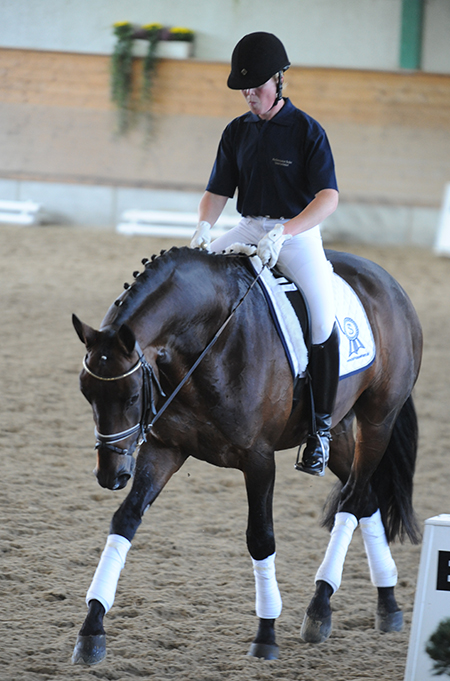
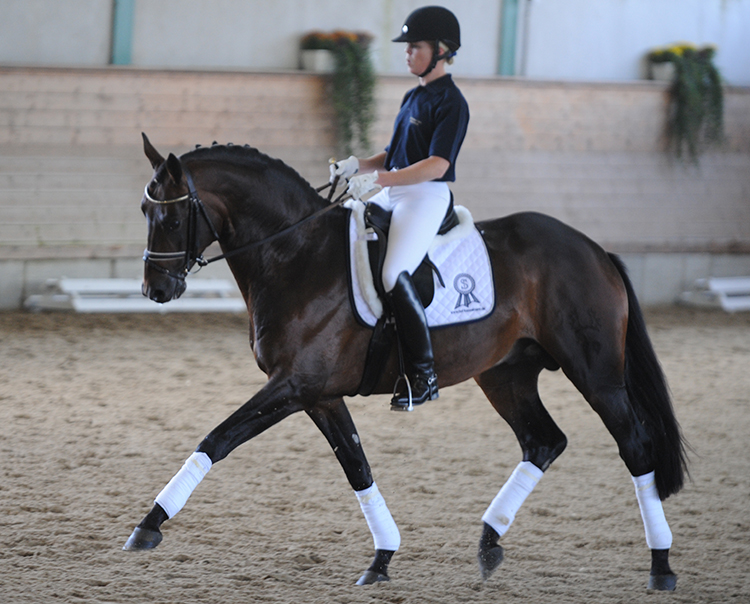
Representing the breeders’ point of view, Werner Schade was asked to comment on the horses:
“We have seen some exceptional horses, but there are a number of points we should consider. One is the connection to the mouth, and the position of the neck. In the last few years there has been much progress producing well-set and light necks. Today, with the last horse, we saw a heavier neck but it was not a disadvantage, as this horse is well-balanced and stable.”
“You need stability, it the neck is too flexible, it is too difficult for the riders. When we look at the first horse, it is very talented, but for a not so experienced rider, it would be a problem.”
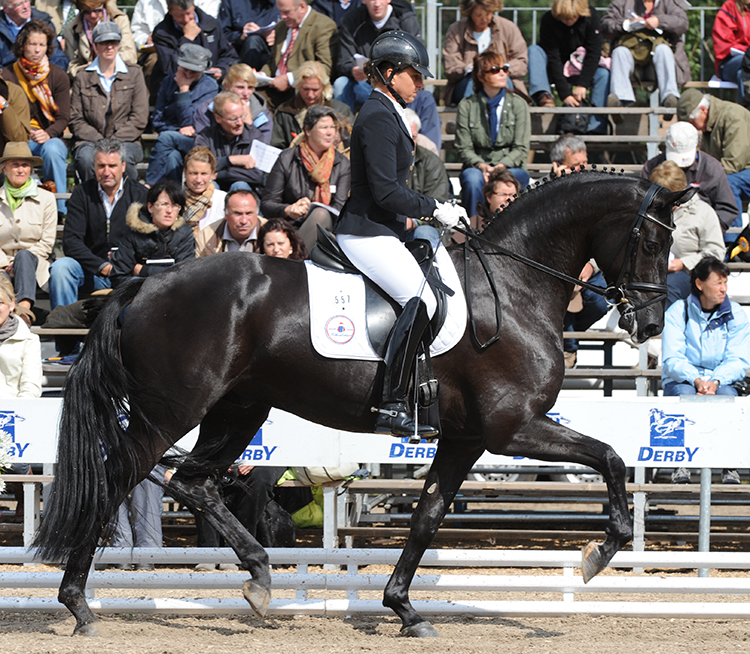
Horatio, by Hochadel, and Dorothee competing at the Bundes Champs earlier in the week
“I have known the nice black Hochadel since he was a two and a half year old at our stallion licensing. He is an example of good training, now he has a good connection from the neck to the back because of training. Sometimes we find that the jumping horses are a little tighter in the back, but it is also our experience that it helps to use a little more jumping blood in our dressage breeding. For example, the champion of the 4 year old stallions, Lissaro van de Helle, is by a jumper stallion and he presented at our licensing as a jumping horse but we see him winning the riding horse class…”
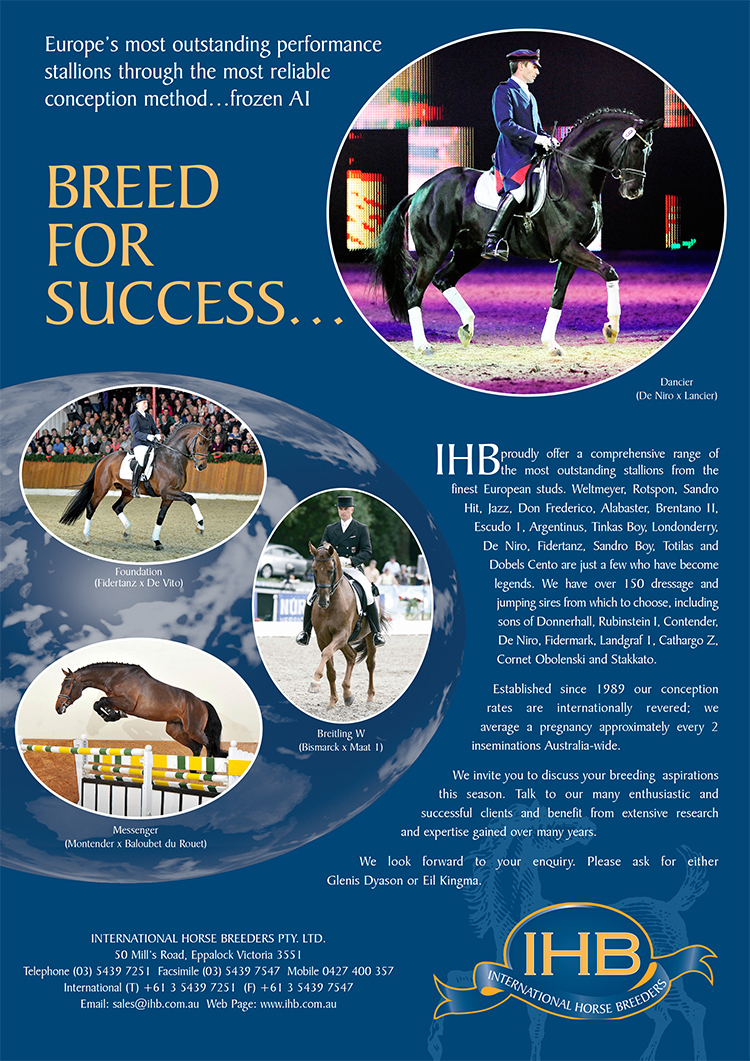


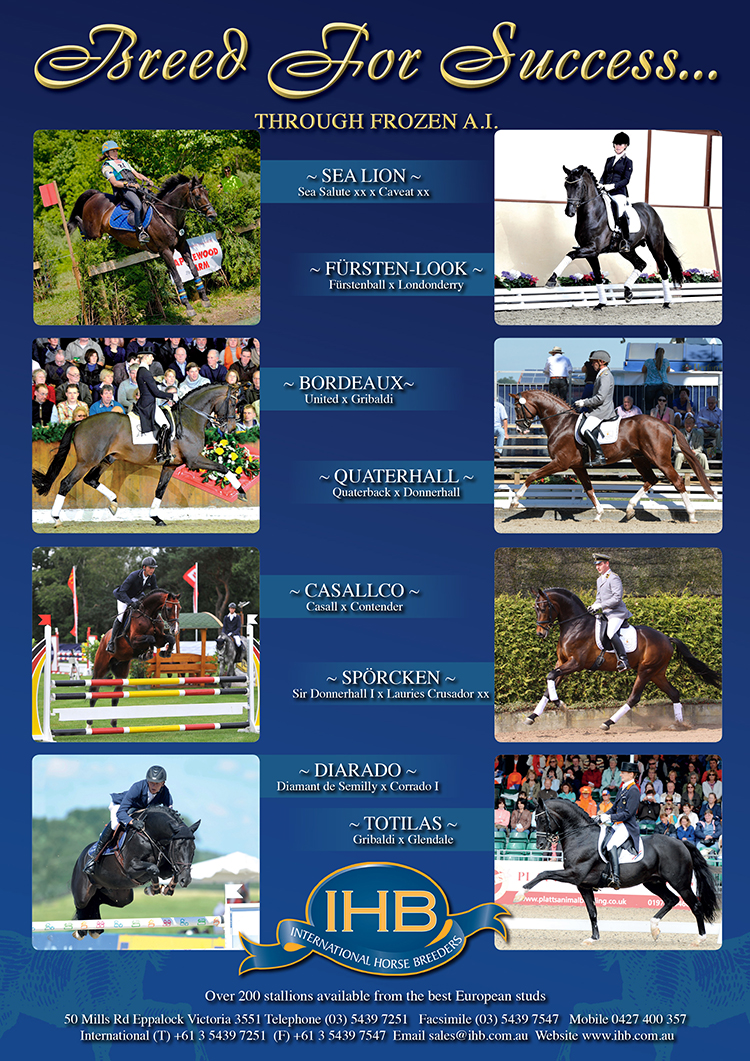

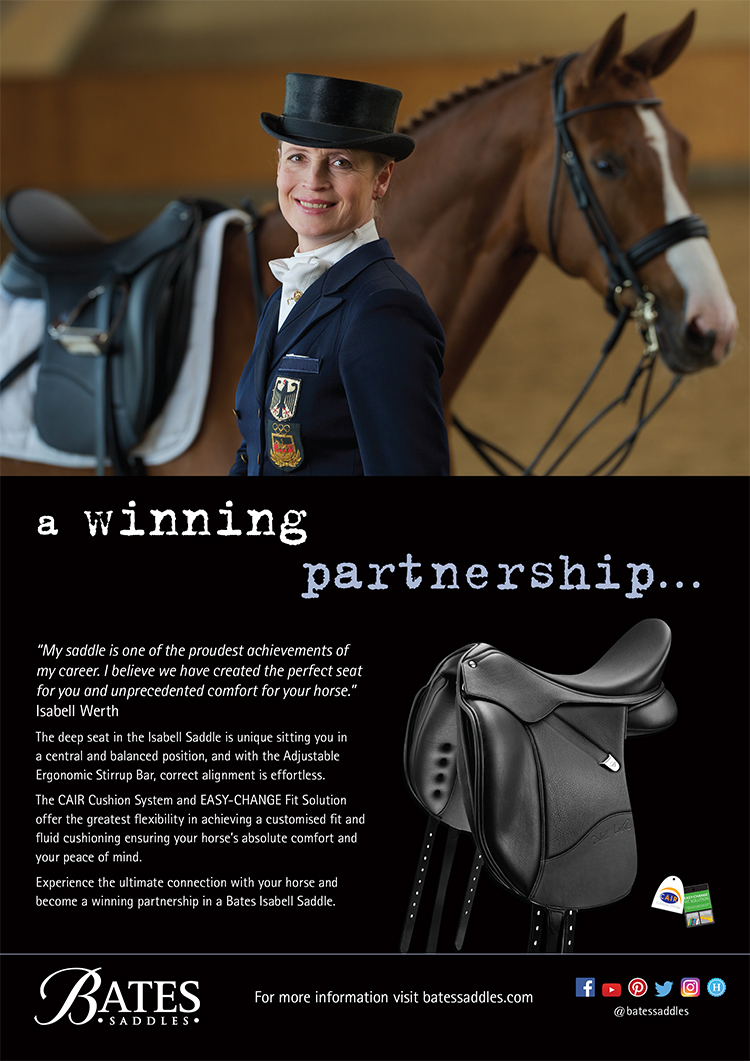

Excellent article.